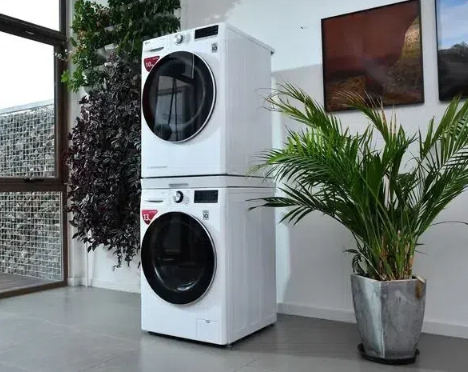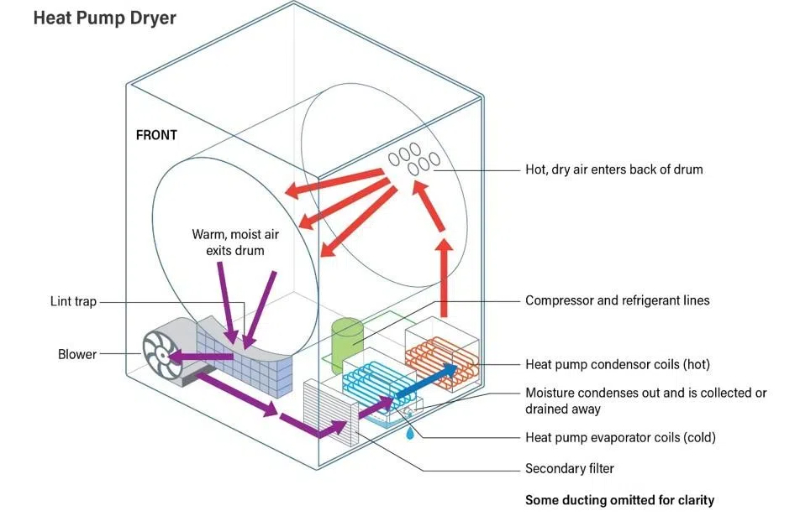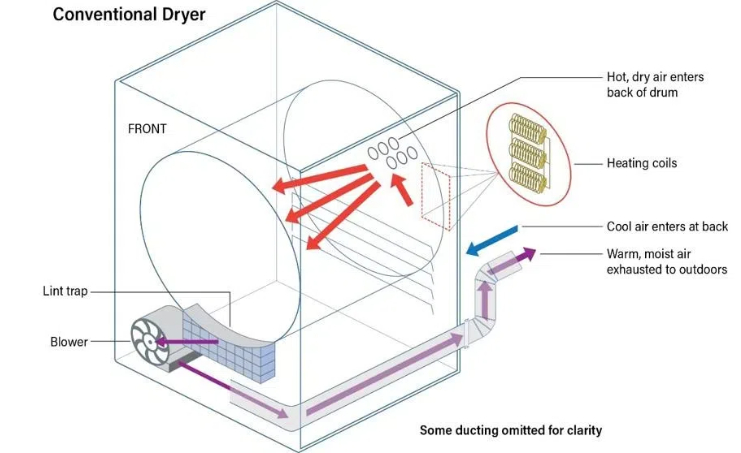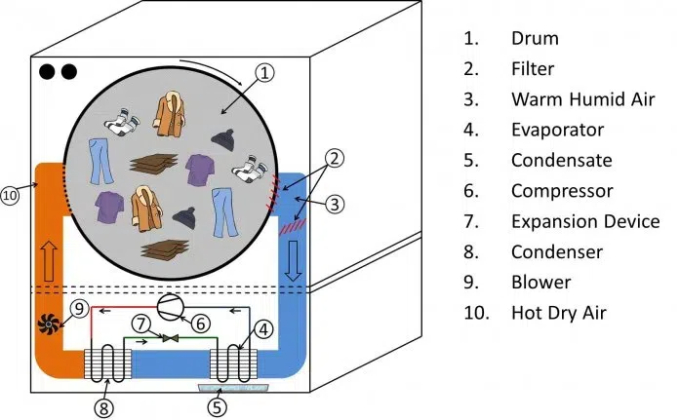
Content Menu
● Introduction to Heat Pump Clothes Dryer Technology
● How Heat Pump Dryers Work: Understanding the Technology
● The Benefits of Heat Pump Dryers: Why They're Worth Considering
>> 1. Energy Efficiency
>> 2. Gentle on Clothes
>> 3. Versatile Installation Options
>> 4. Environmental Impact
>> 5. Advanced Features
● Heat Pump vs. Conventional Dryers: A Comparison
>> Energy Consumption
>> Drying Time
>> Initial Cost vs. Long-term Savings
>> Maintenance
● Choosing the Best Heat Pump Dryer: Factors to Consider
● Installation and Maintenance Tips for Heat Pump Dryers
● The Future of Laundry: Heat Pump Dryers and Beyond
● Conclusion: Is a Heat Pump Dryer Right for You?
● Frequently Asked Questions
>> Q1: How much energy can I save with a heat pump dryer?
>> Q2: Are heat pump dryers suitable for all types of fabrics?
>> Q3: Do heat pump dryers require special installation?
>> Q4: How long do heat pump dryers typically last?
>> Q5: Are heat pump dryers worth the higher upfront cost?
Introduction to Heat Pump Clothes Dryer Technology
In recent years, the laundry industry has witnessed a significant technological advancement with the introduction of heat pump clothes dryers. These innovative appliances have revolutionized the way we dry our clothes, offering a more energy-efficient and environmentally friendly alternative to conventional dryers. As consumers become increasingly conscious of their energy consumption and environmental impact, heat pump dryers have gained popularity for their ability to deliver superior performance while reducing energy costs and carbon footprint.
How Heat Pump Dryers Work: Understanding the Technology
To fully appreciate the benefits of heat pump dryers, it's essential to understand the technology behind them. Unlike traditional dryers that expel hot, moist air outside, heat pump dryers operate on a closed-loop system that continuously recycles and reuses hot air to dry clothes.
The process begins when warm air is circulated through the drum containing wet clothes. As the air absorbs moisture from the garments, it passes through an evaporator coil filled with cold refrigerant. This causes the moisture in the air to condense, separating it from the air stream. The collected water is then either pumped out or stored in a removable container.
Next, the now-cooler air moves through a condenser coil, where it's reheated by the refrigerant. This warm, dry air is then recirculated back into the drum to continue the drying process. This closed-loop system allows heat pump dryers to operate at lower temperatures while still effectively drying clothes.

The Benefits of Heat Pump Dryers: Why They're Worth Considering
1. Energy Efficiency
One of the most significant advantages of heat pump dryers is their exceptional energy efficiency. By recycling hot air and operating at lower temperatures, these appliances can use up to 50% less energy compared to conventional dryers. This translates to substantial savings on energy bills over time, making them an attractive option for cost-conscious consumers.
2. Gentle on Clothes
The lower operating temperatures of heat pump dryers are not only energy-efficient but also gentler on fabrics. This means less wear and tear on your clothes, helping them last longer and maintain their quality. Delicate items that might typically require air-drying can often be safely dried in a heat pump dryer.
3. Versatile Installation Options
Unlike traditional vented dryers that require an external exhaust, heat pump dryers are ventless. This feature allows for more flexible installation options, as they can be placed in various locations within the home without the need for ductwork. This is particularly beneficial for apartments, condominiums, or homes with limited space.
4. Environmental Impact
By consuming less energy, heat pump dryers contribute to a reduction in greenhouse gas emissions. For environmentally conscious consumers, this makes them an appealing choice in the effort to reduce one's carbon footprint.
5. Advanced Features
Many heat pump dryers come equipped with smart technology and sensors that can detect when clothes are dry, preventing over-drying and further reducing energy consumption. Some models also offer Wi-Fi connectivity, allowing users to monitor and control the dryer remotely through smartphone apps.
Heat Pump vs. Conventional Dryers: A Comparison
To better understand the advantages of heat pump dryers, let's compare them to conventional vented and condenser dryers:
Energy Consumption
Heat pump dryers are the clear winners in terms of energy efficiency. While conventional electric dryers typically have energy ratings of 2-3 stars, heat pump models can achieve 7-10 star ratings, indicating significantly lower energy consumption.
Drying Time
One potential drawback of heat pump dryers is that they generally take longer to dry clothes compared to conventional models. This is due to their lower operating temperatures. However, the trade-off is reduced energy consumption and gentler treatment of fabrics.
Initial Cost vs. Long-term Savings
Heat pump dryers often have a higher upfront cost than conventional dryers. However, the energy savings over time can offset this initial investment, especially in households with high dryer usage or in areas with high electricity rates.
Maintenance
Both types of dryers require regular cleaning of lint filters. However, heat pump dryers also have a condenser unit that needs periodic cleaning to maintain optimal performance. Some models feature self-cleaning condensers, reducing maintenance requirements.

Choosing the Best Heat Pump Dryer: Factors to Consider
When shopping for a heat pump dryer, consider the following factors:
1. Capacity: Ensure the dryer's capacity matches your household's needs.
2. Energy rating: Look for models with high energy star ratings for maximum efficiency.
3. Features: Consider options like moisture sensors, multiple drying programs, and smart connectivity.
4. Noise level: Some heat pump dryers operate more quietly than others.
5. Brand reputation and warranty: Choose a reputable brand with good customer support and a solid warranty.
Installation and Maintenance Tips for Heat Pump Dryers
To get the most out of your heat pump dryer:
1. Ensure proper ventilation in the installation area to maintain optimal performance.
2. Clean the lint filter after every use to maintain efficiency.
3. Regularly clean the condenser unit as per the manufacturer's instructions.
4. Use appropriate heat settings for different fabric types to maximize energy savings and protect your clothes.
5. Consider using dryer balls to improve air circulation and reduce drying time.
The Future of Laundry: Heat Pump Dryers and Beyond
As technology continues to advance, we can expect further improvements in heat pump dryer efficiency and features. Manufacturers are already exploring ways to reduce drying times while maintaining energy efficiency. Additionally, the integration of artificial intelligence and machine learning may lead to even smarter dryers that can adapt to user habits and optimize performance automatically.
Conclusion: Is a Heat Pump Dryer Right for You?
Heat pump clothes dryers represent a significant leap forward in laundry technology, offering substantial energy savings, gentler fabric care, and increased flexibility in installation. While they may have a higher initial cost and longer drying times, the long-term benefits in energy savings and reduced environmental impact make them an attractive option for many households.
As with any major appliance purchase, it's essential to consider your specific needs, budget, and usage patterns when deciding if a heat pump dryer is the right choice for you. With their growing popularity and increasing availability, heat pump dryers are poised to become a standard feature in energy-efficient homes of the future.

Frequently Asked Questions
Q1: How much energy can I save with a heat pump dryer?
A1: Heat pump dryers can save up to 50% on energy consumption compared to conventional dryers. The exact savings depend on your usage patterns and local electricity rates, but many users report significant reductions in their energy bills.
Q2: Are heat pump dryers suitable for all types of fabrics?
A2: Yes, heat pump dryers are generally suitable for all fabric types. Their lower operating temperatures make them particularly good for delicate fabrics that might be damaged by high heat in conventional dryers.
Q3: Do heat pump dryers require special installation?
A3: Heat pump dryers are ventless, which means they don't require an external exhaust. This allows for more flexible installation options. However, they do need to be placed in a well-ventilated area and may require a 240-volt electrical outlet.
Q4: How long do heat pump dryers typically last?
A4: With proper maintenance, heat pump dryers can last 10-15 years or more. Their lifespan is often longer than conventional dryers due to their gentler operation and more advanced technology.
Q5: Are heat pump dryers worth the higher upfront cost?
A5: For many households, the answer is yes. While heat pump dryers have a higher initial cost, the energy savings over time can offset this investment, especially for families with high dryer usage or those living in areas with high electricity rates. Additionally, the gentler drying process can help extend the life of your clothes, providing further long-term savings.












